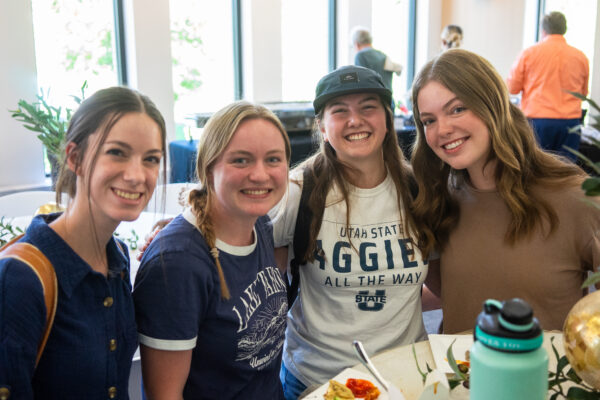Mehdi Heravi Global Teaching and Learning Center officially opens on The Quad
On Oct. 11 at 2 p.m., the Mehdi Heravi Global Teaching and Learning Center officially opened at Utah State University’s Logan campus.
Located on the Quad between Old Main and the Ray B. West building, this new building under the College of Humanities and Social Sciences is the new home for USU’s Department of World Languages and Cultures.
“I am so excited,” said Finley Borgmann, sophomore and volunteer for the German hub. “I’m glad the world languages finally has a building, and them getting their own building now feels like just a really awesome thing where we can all come and hang out.”
“This is an amazing opportunity for students,” said USU President Elizabeth Cantwell. “And I hope all our students understand that this is a place that has so many spaces for you.”
The opening was well attended by students, staff and faculty.

(Left to right) Students Anna Smith, Shelby Wagstaff, Olivia Woodward, and Grace Carson pose for a photo while eating the food from various cultures served in the second-floor pavilion of the new Mehdi Heravi Global Teaching and Learning Center on Oct 11, 2024.
One of the guests was Mehdi Heravi. Born in Tehran, Iran, Heravi attended USU and has had a long career, first in academia and public service before switching to humanitarian efforts. He still maintains strong ties to USU.
Heravi is a notable donor to the university and has established multiple scholarships. He founded the Heravi Peace Institute, an academic program that provides opportunities for educational advancement through experiential learning, research done by both faculty and students and outreach to promote the field of peacebuilding. The institute also provides certificates on topics such as conflict management and social entrepreneurship.
“I hope anyone who goes through this building will become a promoter of peace and a friend of human dignity,” Heravi said.
Cantwell attended the opening ceremony and gave her remarks.
Alongside Cantwell, other speakers included Rebecca Walton, the executive associate dean of CHaSS; Crescencio López González, the head of the world languages and cultures department and Joseph P. Ward, the dean of CHaSS.
The event began with a blessing ceremony done by Rios Pacheco, a tribal elder for the Northwestern Band of the Shoshone Nation.
Guests from different community groups, such as Elders Gary E. Stevenson and Quentin L. Cook, apostles of the Church of Jesus Christ of Latter Day Saints, were in attendance.
After the main ribbon was cut by Heravi at 3 p.m., multiple mini ribbon-cuttings were held for the rooms named after donors, such as the Carolyn Tanner Irish Pavilion and the James L. Ratcliff Administrative Suite. The ceremonies were performed by the respective donors in attendance.
Alongside the ribbon-cutting ceremonies, various cultural hubs hosted small displays for their languages, cultures and snacks.
Each cultural hub is focused on one of the languages taught at USU. The languages are Spanish, Portuguese, Arabic, Chinese, Japanese, German, French, Russian and the Intensive English Language Institute, which provides English courses for non-English speakers.
“I am really excited to have dedicated culture hubs and places where we can collect,” Borgmann said. “I’m part of different culture clubs, and I think it’ll be great to have a dedicated spot.”
“If it is your first time coming to our building, please explore the Logan Canyon, which is what our main corridor represents,” González said. “We have several wind caves or cultural hubs as you walk through our canyon.”
Another feature of the event was the pamphlets received by those attending had a spot within it for stamps, turning every pamphlet into a “passport.” Collecting eight stamps, which could be received at the cultural hubs and other prominent rooms and areas, earned the visitor a small prize.
Food was offered at the event, from Chinese egg rolls to Spanish churros.
“Come visit this building,” Cantwell said. “Come walk through it, even if you don’t have a class here. It is an amazing space, and there are lots of places to sit to study, to contemplate and to learn from your fellow students.”

